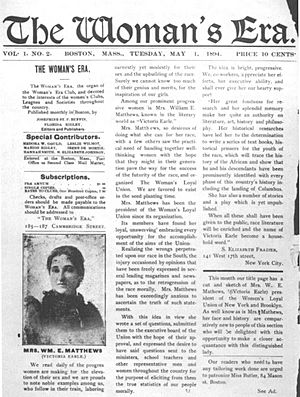The Woman's Era facts for kids

May 1, 1894 issue featuring Victoria Earle Matthews
|
|
| Editor | Josephine St. Pierre Ruffin |
|---|---|
| Frequency | Monthly |
| Format | |
| Founder | Josephine St. Pierre Ruffin |
| Founded | 1894 |
| Final issue | 1897 |
| Country | United States |
| Based in | 103 Charles Street Boston, Massachusetts |
| Language | English |
The Woman's Era was a very important newspaper in the United States. It was the first national newspaper created by and for Black women.
It started as a monthly newspaper in Boston in 1894. Soon, it was sent all over the country. The newspaper ran until January 1897. Josephine St. Pierre Ruffin was its editor and publisher. The Woman's Era played a big part in the national women's club movement for African-American women. This movement helped women work together for change.
Contents
The Woman's Era Newspaper: A Look Back
Starting the Woman's Era Club
In 1892, a leader named Josephine St. Pierre Ruffin started the Woman's Era Club in Boston. She worked with her daughter, Florida Ruffin Ridley, and teacher Maria Louise Baldwin. This was the first club for Black women in Boston. It was also one of the first in the whole country.
What the Club Did
Important Black women from Boston joined this club. They worked hard on many issues. These included education and women's right to vote. They also fought against unfair treatment and violence. Their motto was "Help to make the world better."
The Newspaper's Role
The Woman's Era was the club's own newspaper. It came out every month and had pictures. Ruffin was the editor and publisher. Ridley also helped edit the paper.
What You Could Read in The Woman's Era
News and Interviews
The newspaper had many interesting articles. You could find "Club Gossip" and tips on "Social Etiquette." There were also articles about "Health and Beauty from Exercise."
The Woman's Era shared news about women getting the right to vote in Colorado. Colorado was the second state to allow women to vote. The paper also featured interviews with important activists. These included Victoria Earle Matthews and Ida B. Wells.
Highlighting Important Women
There was a series called "Eminent Women." This series shared stories about famous women. One story was about Harriet Tubman, a hero who helped many people escape slavery.
Speaking Out for Justice
The newspaper also spoke out against unfairness. For example, it criticized some activists who did not meet their expectations. These included Frances Willard and Albion W. Tourgée.
In 1894, an article called "How to Stop Lynching" was published. Lynching was a terrible act of violence against Black people. The article asked why murderers of Black people were not punished. It said the government should protect its citizens. The editor believed the federal government needed to step in.
A National Voice for Women
In 1895, Josephine Ruffin organized a big meeting. It was called The First National Conference of the Colored Women of America. At this meeting, the National Federation of Afro-American Women was created. This new group brought together women's clubs from all over the country. The Woman's Era then became the main newspaper for all these club women. It helped them share news and ideas across the nation.
Images for kids
-
May 1, 1894 issue featuring Victoria Earle Matthews


